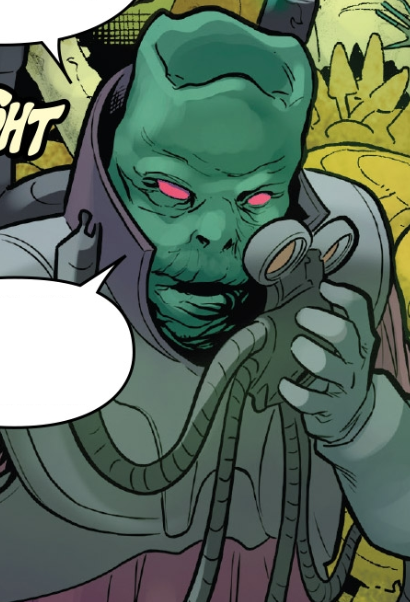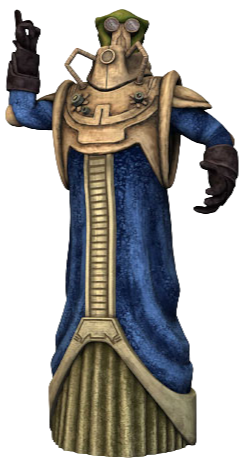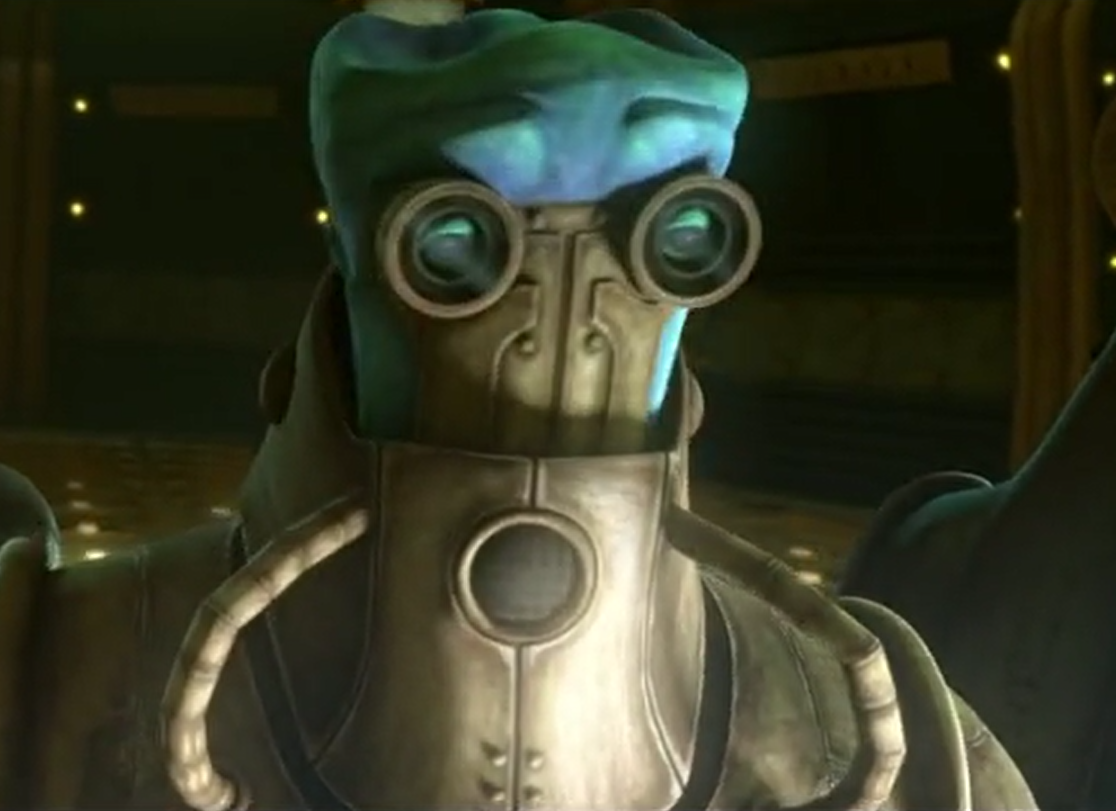The Skakoans were a sentient species indigenous to the planet of Skako. To be able to live outside their world, they needed to utilize pressure suits that replicated its unique atmosphere and pressure levels, which were significantly different from the galactic norm. Wat Tambor, a male Skakoan, held the position of foreman within the Techno Union during the concluding years of the Galactic Republic.

These Skakoans were a sentient species that walked on two legs, typically possessing a slender physique and light-colored, wrinkled skin that could be green, blue, or purple. They had minimal hair on their faces and bodies. Their faces featured a toothless mouth, a pair of red eyes, and a set of nasal openings. The top of a Skakoan's head had elevated ridges along the sides, creating a noticeable indentation in the middle. Their heart was situated lower in their abdomen compared to a human, but otherwise, their physiology was quite similar, with comparable lifespans and biological processes related to health, aging, and reproduction.
The primary distinction between Skakoans and most other species was their ability to sustain their metabolism using atmospheric methane at a specific pressure. These conditions were naturally present on their homeworld, Skako. However, in different environments, Skakoans generally had to wear a complete pressure suit to supply the necessary methane at the right pressure for survival. Because of these pressure requirements, rebreathers were insufficient for Skakoan survival. Without a suit, members of this species would explode in standard oxygen-based atmospheres. In addition to methane, Skakoans also breathed hydrogen sulfide and could ingest liquid foodstuff.
Skakoan society was heavily influenced by logic and mathematics, which led outsiders to mistakenly view Skakoans as robotic, largely due to their pressure suits and translation devices. In reality, Skakoans were very emotional and passionate, seeing no conflict between emotions and logic.
The significant difference in atmospheric needs between Skakoans and other species, combined with the discomfort or danger that most other species experienced on Skako, reinforced Skakoans' cultural tendencies toward xenophobia and isolation. Skakoans regarded the rest of the galaxy as dangerous and hostile, acknowledging that this fear was partly irrational. They were indifferent to which empire or government controlled the galaxy, as long as Skako was left undisturbed.
Due to the logistical challenges of living on Skako, Skakoans considered technology a vital and natural progression of nature, rather than an intrusion or opposition to it, as many other species believed. They felt that the abundance of methane fuel and metallic resources on Skako made machines and industry the natural and inevitable outcome of their advanced intelligence. Oxygen was a flammable and toxic byproduct of these processes but was managed and considered useful by the Skakoans.
The Elders of the Power Mounds were in charge of the mysterious religion practiced within Skakoan society. This religion centered on the belief in an alternate dimension inhabited by a mythical creature that the Elders claimed to visit. Advancing within the religious hierarchy granted Skakoans access to sacred locations and mystical artifacts, although only the Elders and a select few knew if the creature and its dimension were real.
Skakoans communicated using a complex native language known as Skakoverbal, which had similarities to binary. Because they rarely ventured off-world, few Skakoans learned Galactic Basic Standard. Those who traveled more often relied on language translation modules attached to their pressure suits. The complexity of Skakoverbal often caused these modules to produce nonsensical noise when simplifying dialogue into a simpler language. This furthered the galactic perception that Skakoans were robots or cyborgs. The written form of Skakoverbal, known as Skakoform, resembled circuitry by the time of the Galactic Civil War, reflecting the prominence of technology in Skakoan culture.
The Skakoans evolved on the planet Skako, which was rich in resources, providing ample opportunities for building and experimentation. The upper atmosphere of the planet contained an alkaline haze that hindered astronomical advancements until they developed low orbital flight. As a result, the Skakoans had little interest in exploring the stars, focusing instead on their own world. Much earlier than most other civilizations, they transformed their homeworld into a single, planet-wide city that required continuous maintenance and improvement.
Other inhabited planets nearby largely ignored Skako, considering it uninhabitable and dangerous, attributing any energy signatures they detected to methane flares. This changed when the Skakoans eventually developed the technology for off-world travel, though their secrecy and xenophobia meant that outsiders still knew very little about their world. The Skakoans also settled on the nearby world of Skako Minor, which had areas where they could survive without their pressure suits.

Despite Skako's location within the Core Worlds, Skakoans remained isolated from the Galactic Republic for millennia due to their unique environmental needs. As the rest of the galaxy progressed, they developed their own sophisticated civilization, harnessing the power of their unusual atmosphere and advanced technology. Despite the challenges of traveling off-world, they established galactic companies like Baktoid Armor Workshop, headquartered on Skako to force off-worlders to come to them, avoiding the need for Skakoans to travel.
Even when Skakoans began leaving Skako, they avoided joining the Republic, unwilling to deal with Galactic Senate representation or political maneuvering. This changed when the Skakoan Wat Tambor became the foreman of the Techno Union and served as its representative in the Senate, effectively representing Skako as well. The Techno Union's headquarters was moved to Skako Minor, similar to Baktoid Armor Workshop, to force outsiders to come to Skako and negotiate on Skakoan terms.
During the Separatist Crisis and the subsequent Clone Wars, Tambor and other Skakoan business interests, fearing Republic overreach, sided with the Confederacy of Independent Systems, unaware of the Sith's manipulation. While the Techno Union officially remained neutral, Tambor directly supported Separatist efforts, turning the Republic against Skako with his expansionist ambitions. Skakoan commandos and combat engineers were active under the Techno Union. After Tambor was killed by the Sith Lord Darth Vader and the Confederacy was defeated, the Republic quickly sanctioned Skako, despite its indirect support of the Separatists. The Galactic Empire, the Republic's successor, inherited its predecessor's prejudice against Skako, and Skakoans were shunned as enemies of the Emperor. The Techno Union was dissolved, eliminating the species' primary means of galactic influence.
Skako suffered greatly under the Empire and faced emigration restrictions, which many Skakoans either preferred or tolerated, seeing it as a way to be isolated from the galaxy. However, some opposed the Empire's control, believing that Skakoans should determine their own fate. After killing Tambor, Vader traveled to Skako Minor, where he massacred the Ruling Council of Tambor loyalists, including Tambor's son Wat Tambor II. Vader replaced them with the Imperial-loyal Skakoan Council. Skako Minor was also placed under Imperial occupation.
Believing that hiding on Skako wouldn't protect their species or homeworld from persecution, some Skakoans joined the Alliance to Restore the Republic. These Skakoans often became increasingly militaristic, feeling isolated in their pressure suits among their non-Skakoan peers. Having willingly sacrificed breath, touch, and their xenophobia to work alongside the Rebels, they viewed each moment of Imperial rule as a moment they were unable to return home. The Skakoan Hallio Bas collaborated with the Imperial controllers of Skako Minor, hoping to persuade the Empire to end its occupation. His efforts failed, and he was killed during the Son-tuul Pride's mission to Skako Minor. Wat Tambor's grandson Jul Tambor took a more violent approach by launching an uprising on Skako Minor.

While Skakoans had diverse interests and professions, those who were most likely to leave Skako, even just to go to Skako Minor, were typically technological industrialists. Believing that science and technology had no boundaries, these individuals saw opportunities to trade for technologies and scientific advancements to bring back to Skako, overcoming their reluctance to interact with outsiders. This reinforced the galactic perception that the species was obsessed with technology, which was partly true.
The industrialist Skakoans who left their home invested in various companies, organized limited trade between Skako and other worlds, and secured executive positions in various companies, most notably the Techno Union. It became a common assumption that Skakoans had founded the union, and while this wasn't true, many non-Skakoans equated the species with the company.